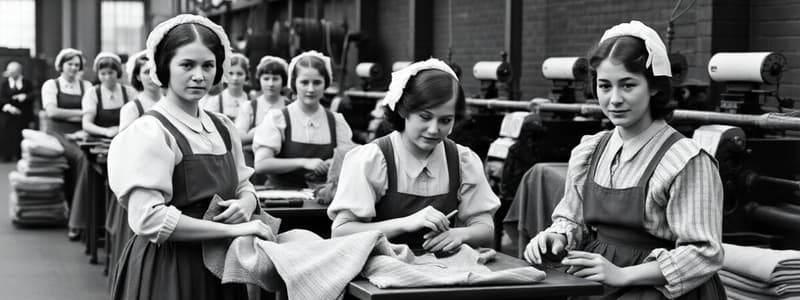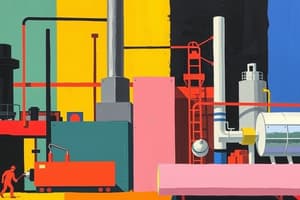Podcast
Questions and Answers
What was the primary difference between the pre-industrial economy and the economy that emerged during the market revolution?
What was the primary difference between the pre-industrial economy and the economy that emerged during the market revolution?
- A shift from capitalist ventures to socialist ventures.
- A transition from a pre-industrial economy to a market-oriented capitalist economy. (correct)
- A transition from an agricultural economy to a service-based economy.
- A transition from local production to small-scale production.
How did the introduction of the factory system change the structure of the family economy?
How did the introduction of the factory system change the structure of the family economy?
- It reinforced the traditional family economy by increasing the productivity of small farms and shops.
- It led to a separation of work roles, where men and women often worked in different locations or spheres. (correct)
- It brought families closer together as they worked side-by-side in large factories.
- It dissolved the family structure, with individuals becoming economically independent.
Why were young women and girls, such as the Lowell Mill girls, specifically targeted as workers in the textile factories?
Why were young women and girls, such as the Lowell Mill girls, specifically targeted as workers in the textile factories?
- They possessed superior mechanical skills compared to men.
- They were more resistant to the harsh working conditions.
- They could be paid less than men for the same work. (correct)
- They were less likely to strike or form labor unions.
In the context of the Industrial Revolution, what is the key difference between an inventor and an innovator?
In the context of the Industrial Revolution, what is the key difference between an inventor and an innovator?
How did the introduction of interchangeable parts impact the manufacturing process and the identity of the United States?
How did the introduction of interchangeable parts impact the manufacturing process and the identity of the United States?
What effect did Fulton's steamboats have on river transportation and commerce?
What effect did Fulton's steamboats have on river transportation and commerce?
How did the introduction of Deere's steel plow and McCormick's mechanical reaper transform agriculture in the Great Plains?
How did the introduction of Deere's steel plow and McCormick's mechanical reaper transform agriculture in the Great Plains?
What was a key challenge faced by Americans moving west and south in the early 1800s, and what did they realize they needed to overcome this challenge?
What was a key challenge faced by Americans moving west and south in the early 1800s, and what did they realize they needed to overcome this challenge?
How did the cotton gin impact the economic relationship between the North and South in the United States?
How did the cotton gin impact the economic relationship between the North and South in the United States?
What was the primary consequence of the 1807 law that ended the international slave trade for the United States?
What was the primary consequence of the 1807 law that ended the international slave trade for the United States?
How did enslaved African Americans respond to forced separations caused by the interstate slave trade?
How did enslaved African Americans respond to forced separations caused by the interstate slave trade?
Why was literacy among enslaved people viewed as a threat by slaveholders?
Why was literacy among enslaved people viewed as a threat by slaveholders?
How did Henry Clay's American System aim to promote economic growth and national unity in the early 19th century?
How did Henry Clay's American System aim to promote economic growth and national unity in the early 19th century?
What political shift is marked by James Monroe's re-election in 1820?
What political shift is marked by James Monroe's re-election in 1820?
How did the Supreme Court case McCulloch v. Maryland strengthen federal power?
How did the Supreme Court case McCulloch v. Maryland strengthen federal power?
What was the main objective of the Missouri Compromise?
What was the main objective of the Missouri Compromise?
What was the primary goal of the Monroe Doctrine, as articulated by President James Monroe in 1823?
What was the primary goal of the Monroe Doctrine, as articulated by President James Monroe in 1823?
What did the National Road, the B & O Railroad, and the Erie Canal have in common?
What did the National Road, the B & O Railroad, and the Erie Canal have in common?
Flashcards
Market Revolution
Market Revolution
Transition from a pre-industrial economy to a market-oriented capitalist one.
Industrial Revolution
Industrial Revolution
Production by machinery that began in the mid-1700s in Europe.
Factory System
Factory System
A method of production where large groups work together in one place.
Textile Industry
Textile Industry
Signup and view all the flashcards
Lowell Mill Girls
Lowell Mill Girls
Signup and view all the flashcards
Inventors
Inventors
Signup and view all the flashcards
Innovators
Innovators
Signup and view all the flashcards
Interchangeable Parts
Interchangeable Parts
Signup and view all the flashcards
National Road
National Road
Signup and view all the flashcards
Erie Canal
Erie Canal
Signup and view all the flashcards
Cotton Gin
Cotton Gin
Signup and view all the flashcards
Nationalism
Nationalism
Signup and view all the flashcards
Protective Tariffs
Protective Tariffs
Signup and view all the flashcards
Subsidies
Subsidies
Signup and view all the flashcards
McCulloch v. Maryland
McCulloch v. Maryland
Signup and view all the flashcards
Gibbons v. Ogden
Gibbons v. Ogden
Signup and view all the flashcards
Missouri Compromise
Missouri Compromise
Signup and view all the flashcards
Monroe Doctrine
Monroe Doctrine
Signup and view all the flashcards
Study Notes
- The market revolution marks a shift from a pre-industrial economy to a market-oriented capitalist economy.
- It was driven by the industrial revolution, which involved widespread production by machinery since the mid-1700s in Europe.
- In 1793, Samuel Slatter opened the first cloth factory in Rhode Island.
- Industrialization in the Northeast changed both social structures and the nation's economy.
Changes in the Economy
- The factory system involves large groups of people working in one location.
- The traditional family economy where families worked together on small farms or shops shifted to men and women working in separate spheres.
The Mill Girls
- The US entered the industrial revolution through textiles.
- The textile industry involves producing cloth and clothing from raw materials like cotton.
- The Lowell Mill girls, some as young as 10, were young women who worked in textile factories for lower wages than men.
- The Lowell Mill girls lived in boarding houses and had independence.
- The Lowell Offering was a monthly publication featuring the girls' writing and poetry.
- Factory conditions and long hours led to strikes, and the workers formed the Lowell Female Labor Reform Association (LFLRA).
New Inventions and Innovations
- Inventors create something entirely new, while innovators improve upon existing ideas.
- Interchangeable parts allowed goods to be produced faster and at a lower cost.
- The use of interchangeable parts helped shape the US identity as a nation of problem-solving, ingenuity, and progress.
Steamboats and Telegraphs
- New technologies changed shipping, communication, and agriculture.
- Fulton's steamboats allowed ships to sail upstream, enabling goods to travel both ways on rivers like the Mississippi and Ohio.
- Morse's telegraph allowed for near-instantaneous communication over long distances.
- Deere's steel plow was made of hard, polished steel that didn't allow prairie soil to clump.
- McCormick's mechanical reaper eliminated the need to harvest wheat by hand, leading to a boom in wheat production through the Great Plains.
Overcoming Obstacles
- In the early 1800s, Americans moving west and south needed more efficient ways to transport people and goods.
- Distance and topography posed geographical challenges.
- To overcome these challenges, they built the National Road (a mostly paved road through the Appalachian Mountains), the B&O Railroad (from Baltimore to Ohio), and the Erie Canal (connecting the Hudson River to the Great Lakes).
The Cotton Boom
- The cotton gin brought the North and South closer together economically.
- The cotton gin made removing seeds from cotton less labor-intensive
- Cotton production became more efficient after the invention of the cotton gin
- The North and South both benefited because cotton grown in the South was used for textile production in the North.
Slavery Expands
- In 1807, Congress passed a law ending the slave trade with other countries.
- This law led to an increase in the interstate slave trade
- The interstate slave trade separated enslaved communities as slaves were sold to plantations in other states; enslaved communities responded by broadening kinship bonds.
The Impact of Slavery
- Free African Americans needed certification and certificates of freedom to avoid being considered fugitive slaves.
- Even with certificates, many were kidnapped and sold into slavery.
- Enslaved people resisted by interpreting scripture for themselves and composing songs called spirituals.
- Literacy for enslaved people was seen as a threat because it humanized them and because it was a form of passive resistance.
Rebelling Against Their Captors
- Gabriel Prosser, inspired by the Haitian Revolution, planned a revolt in 1800.
- Denmark Vesey attempted a rebellion to burn Charleston, South Carolina.
- Nat Turner's 1831 rebellion involved a group of enslaved people killing over 50 slave-holding men, women, and children.
Transportation and Commerce
- The Market Revolution encouraged nationalism (loyalty or devotion to one's nation).
- Henry Clay and John C. Calhoun advocated for protective tariffs to promote American manufacturing and stimulate commerce.
- Clay and Calhoun also supported subsidies, which were government funds to support commerce.
- Land subsidies (land granted to private companies by the government) became an important part of building roads and railroads.
- Henry Clay's American System supported the use of protective tariffs and government subsidies, as well as the reestablishment of the National Bank.
New Boundaries, New Decisions
- The Adams-Onís Treaty of 1819 gave Florida to the United States and Texas to Spain.
- The years following the War of 1812 were peaceful.
- The 1816 election of James Monroe began the Era of Good Feelings.
- By 1820, the Federalist Party was no longer a major political force, and James Monroe was re-elected without any opposition.
- The 1820s saw important Supreme Court rulings that strengthened federal power, including McCulloch v. Maryland and Gibbons v. Ogden.
- McCulloch v. Maryland determined that the necessary and proper clause of the Constitution gave the federal government implied powers.
- Gibbons v. Ogden determined that the federal government can prevent the formation of a monopoly and regulate interstate commerce.
The Missouri Compromise
- Sectionalism is the identification with and loyalty to a particular part or section of the country.
- The Missouri Compromise attempted to solve the problem of an imbalance in the number of free and slave states.
- The Missouri Compromise allowed for escaped slaves to be captured and returned to their owners, even if they had escaped to free states.
- The Arkansas Territory was open to slavery and the unorganized territory was closed to slavery.
The Monroe Doctrine
- In 1823, President Monroe introduced the Monroe Doctrine, a new approach to foreign policy.
- The goal of this doctrine was to prevent European countries from interfering in the affairs of the Western Hemisphere.
- Monroe was concerned about European colonial power in Central and South America.
- Monroe: essentially stated that European powers should stay out of the Western Hemisphere and the US would stay out of theirs.
Studying That Suits You
Use AI to generate personalized quizzes and flashcards to suit your learning preferences.
Description
The market revolution marked a shift to a market-oriented capitalist economy, driven by the industrial revolution. The US entered the industrial revolution through textiles. The Lowell Mill girls were young women who worked in textile factories.



